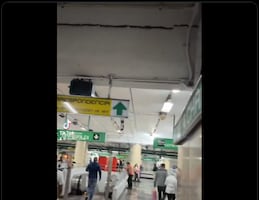Más Información

Sismo en CDMX: “Nos sacó un susto porque se movió como gelatina”, relata empleado de estacionamiento público

Sheinbaum pide a Segob ampliar protección a periodistas tras caso de Rafael León; "por encima de todo está la libertad de expresión"

Nombran a Miguel Hernández Velázquez inspector y contralor del Ejército, Fuerza Aérea y GN; destaca en la lucha contra el narco

Sheinbaum dice que relevo en Cofepris fue decisión de Kershenobich; Víctor Hugo Borja entró en funciones el 1 de enero

Explosión de tanque de gas en puesto de comida deja 17 heridos en Puebla; entre ellos hay menores de edad
The Armed Conflict Location & Event Data Project (ACLED) included Mexico in its special report concerning the 10 conflicts to worry about in 2020 . The report also includes countries like Yemen, India, Somalia, Iran, Afghanistan, Lebanon, the United States, among others.
According to the NGO, despite the onset of the COVID-19 pandemic , violence has not decreased and on the contrary, criminal organizations were quick to take advantage of the crisis and lockdown.
In July 2020, ACLED recorded more violence against civilians involving gangs, though a slightly lower number of civilian fatalities, compared to July 2019. Though lockdown measures resulted in a net decrease of petty crime by 40% and a 20% drop in kidnappings and theft compared to 2019, drug dealing rose by 12%. Several conclusions can be drawn from these figures and their implications for the gang landscape in Mexico. Weakened cartels and smaller splinter groups rely on diversified sources of revenue such as kidnapping , extortion , fuel theft , and human trafficking , all of which were significantly impacted by COVID-19 confinement policies. So far in 2020, ACLED records a sharp drop in kidnappings perpetrated by criminal groups.
Recommended: Deadly Mexican cartel delivers food to impoverished communities amid the COVID-19 pandemic
On the other hand, “larger cartels that are able to withstand the crisis have kept business as usual: drug seizures, armed clashes, and violence against civilians involving criminal groups have not been affected by coronavirus restrictions, remaining at similar overall levels compared to 2019.” At the same time, some criminal groups used the weakening of their rivals as an opportunity to further expand their territory. The Jalisco New Generation Cartel ( CJNG ), one of the most powerful and violent cartels currently operating in Mexico, increased its activities in states bordering its stronghold, such as in Tamaulipas, where they had a limited presence last year. Turf wars between cartels over the control of drug trafficking routes also intensified.

In Michoacán, clashes between the CJNG and its rival Los Viagras exceed that of 2019 already. Similarly, clashes between the Gulf Cartel and the Northeast Cartel over control of the Mexico-U.S. border in Tamaulipas have reached unprecedented levels compared to 2019.
Amid violent clashes and violent attacks, criminal groups have been waging a battle over popular support and have used the COVID-19 pandemic to reinforce their popularity through the distribution of branded aid. In some areas, cartels enforced curfews to prevent the spread of the coronavirus, threatening anyone daring to defy the measure.
Furthermore, the report adds that in the context of heightened gang violence, fear that cartels may overpower Mexican state forces persists. In July, following the release of a video displaying a procession of CJNG members a few days before his visit, President Andrés Manuel López Obrador renewed his vow to tackle organized crime by fighting poverty and preventing further cartel recruitment. Due to the economic fallout from the coronavirus pandemic, and with gangs positioning themselves as humanitarian benefactors, this commitment may prove difficult to fulfill, especially after thousands have lost their jobs.
Recommended: Homicides and violence are on the rise in Mexico despite the COVID-19 pandemic
The NGO claims Mexico’s “security strategy has so far failed to bear fruit” and adds that by some accounts, coronavirus lockdown measures could increase the visibility of cartel activities and play in favor of the Mexican state. The capture of “El Marro," the leader of the Santa Rosa de Lima Cartel on August 2 was a significant victory for Mexican law enforcement; however, the number of drug seizures and clashes between criminal groups and law enforcement remain similar to levels recorded before the pandemic.
It explains that although Mexico created and deployed the National Guard six months ago, “the Mexican government still struggles to contain the growth of gang activities.” In 2020, the participation of the National Guard in battling narco-trafficking groups only accounted for 10% of clashes. The National Guard has at times shifted from its primary security function and instead contributed to the Mexican government’s efforts to curb illegal immigration or to guard coronavirus supplies and facilities during the pandemic.
Moreover, the Armed Conflict Location & Event Data Project explains “civilians continue to be both caught in the crossfire and used as a medium for macabre messages sent between criminal groups.” In Guanajuato, 26 people were killed in an attack launched by the Santa Rosa de Lima Cartel targeting a drug rehabilitation center. Additionally, journalists and politicians continue to be targeted, underscoring the cartel stranglehold on Mexican institutions weakened by rampant corruption . This trend is expected to worsen as the COVID-19 pandemic continues in cases where attacks can be monetized, as demonstrated by the recent kidnapping of a mayor in the state of Tamaulipas by the Gulf Cartel. The Gulf Cartel is aiming to diversify its activity by engaging in targeted kidnappings to increase its liquidity amid the pandemic. More worrying, criminal groups have begun forcefully recruiting children to participate in clashes in the Tierra Caliente, a hotspot for gang violence.
The report concludes that “increased levels of violence are expected as the country resumes economic activity. As it struggles to address the pandemic, Mexico’s government is facing evolving challenges in the fight against organized crime. Smaller groups that were hit harshly by coronavirus lockdown measures will further splinter and redouble violence to recover from their economic losses. Larger groups will continue to strengthen their former and newly acquired territories, presaging intensified clashes with both state forces and rival gangs. Civilians will certainly be the main targets of new cartel strategies to rebuild revenue while deepening poverty could create a steady stream of fresh recruits.”
gm
Noticias según tus intereses
[Publicidad]
[Publicidad]









